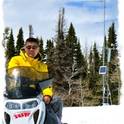
NSF, Division of Atmospheric and Geospace Sciences (AGS)
Tree-ring carbon isotope discrimination (Δ13C) and oxygen isotopes (δ18O) collected from white pine (Pinus strobus) trees adjacent to Lake Superior show potential to produce the first winter-specific paleoclimate reconstruction with inter-annual resolution for this region. Isotopic signatures from 1976 to 2015 were strongly linked to antecedent winter minimum temperatures (Tmin), Lake Superior peak ice cover, and regional to continental-scale atmospheric winter pressure variability including the North American Dipole. The immense thermal inertia of Lake Superior underlies the unique connection between winter conditions and tree-ring Δ13C and δ18O signals from the following growing season in trees located near the lake. By combining these signals, we demonstrate feasibility to reconstruct variability in Tmin, ice cover, and continental-scale atmospheric circulation patterns (r ≥ 0.65, P < 0.001).
